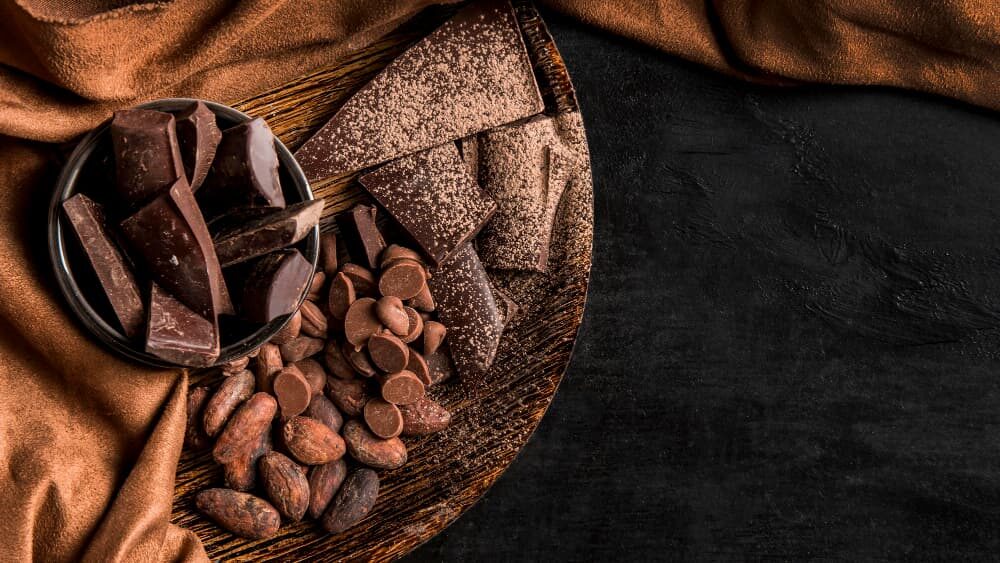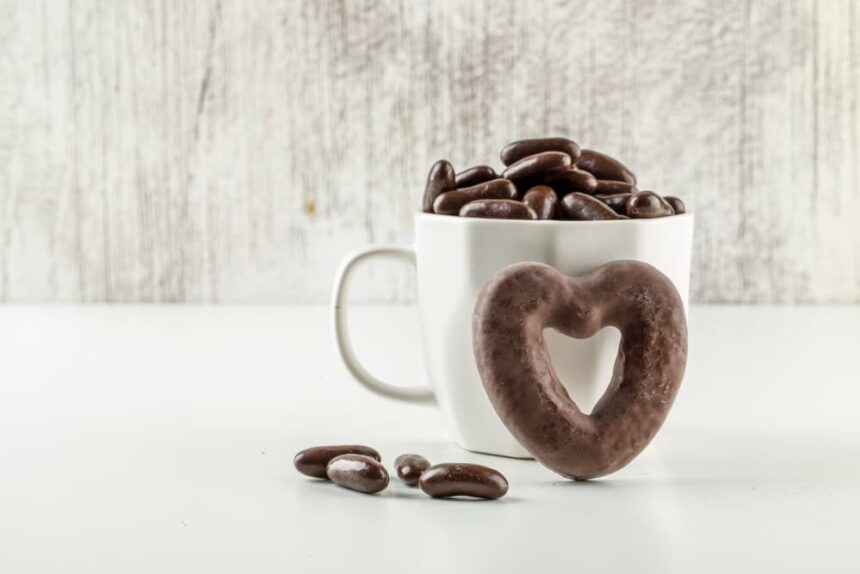You’ve probably seen the headlines—“Dark chocolate is good for you!” But is that actually true, or just wishful thinking?
Some studies link it to lower blood pressure, better brain function, even improved blood flow. But others raise red flags about sugar, calories, and toxic metals found in some brands.
So, is dark chocolate healthy?
The short answer: Yes—but only if you choose the right kind and eat it the right way. Let’s unpack the science, the benefits, and the smartest ways to enjoy it without guilt.
What Makes Dark Chocolate “Healthy”?
You’ve seen the headlines: dark chocolate is good for you.
But why is dark chocolate healthy—really?
The answer lies in three key compounds that naturally occur in cacao: flavanols, polyphenols, and epicatechin. These plant-based antioxidants help reduce inflammation, improve blood flow, and protect your cells from oxidative stress (aka early aging and chronic disease triggers).
🍫 Antioxidant Power: How It Actually Works
Flavanols act like microscopic bodyguards.
They neutralize free radicals—unstable molecules that damage your cells over time.
This process reduces your risk of heart disease, brain fog, and even certain cancers.
Dark chocolate ranks high on the ORAC scale (a measure of antioxidant capacity), outperforming even blueberries and acai berries in some tests.
✅ Why the % of Cacao Matters
Not all chocolate is created equal.
To get any real benefit, look for dark chocolate that’s at least 70% cacao.
More cacao = more flavanols.
Less sugar. Less milk fat. More of the good stuff.
Tip: 85%+ is even better, but may taste more bitter—try a few options to see what works for you.
🏭 How Processing Changes the Game
Here’s the catch: how chocolate is made affects how healthy it is.
Excessive processing or alkalization (aka “Dutching”) strips out most of the flavanols.
Mass-market brands may contain very little antioxidant benefit—despite the “dark” label.
When possible, choose:
- Minimally processed dark chocolate
- Brands that list flavanol content or origin
- Organic or single-origin varieties
💡 Summary: Dark chocolate is healthy when it’s high in cacao, low in additives, and rich in natural antioxidants. Always check the label—your body deserves the real deal.
🍫 7 Proven Benefits of Dark Chocolate
Let’s get specific.
Here are 7 science-backed reasons to keep a square of dark chocolate in your day—if it’s the right kind (think 70%+ cacao and low sugar).

1. ❤️ Supports Heart Health
One of the most well-studied benefits of dark chocolate is its cardiovascular support.
The flavanols in dark chocolate stimulate nitric oxide (NO) production in the endothelium (the inner lining of blood vessels). This helps blood vessels relax, improving vascular function and potentially lowering blood pressure.
📚 A meta-analysis published in The American Journal of Clinical Nutrition found that regular flavanol intake may significantly reduce the risk of cardiovascular disease.
2. 🔄 Enhances Blood Flow
Dark chocolate doesn’t just taste good—it literally helps your blood move better.
Improved circulation means better oxygen and nutrient delivery to your muscles, brain, and skin. This can boost exercise performance, accelerate recovery, and support long-term heart and metabolic health.
💡 Some studies even suggest a mild endurance boost in athletes who consumed dark chocolate before training.
3. 🌱 May Boost Stem Cell Activity
Early-stage research shows that epicatechin, a key antioxidant in dark chocolate, may stimulate the regenerative activity of muscle stem cells—especially in aging populations.
Animal studies and preliminary human trials suggest epicatechin may improve mitochondrial function, muscle strength, and cellular repair over time.
⚠️ While still an emerging area of research, it shows promising potential in sports medicine and anti-aging science.
4. 🧠 Improves Brain Function
Dark chocolate supports the brain in two keyways:
- Flavanols enhance blood flow to the brain, which improves memory, reaction time, and learning
- A small dose of caffeine + theobromine can boost alertness and mood
🧪 In one study, participants who consumed high-flavanol cocoa showed measurable improvements in executive function and attention span.
The benefits are subtle but build up with consistent, moderate intake.
5. 💉 Helps Balance Blood Sugar
Despite its reputation as sweet, dark chocolate may actually help regulate blood sugar.
Flavanols appear to improve insulin sensitivity, reduce systemic inflammation, and may help stabilize energy levels—especially when eaten in moderation.
⚠️ Diabetics should still check labels for sugar content, but 85% cacao chocolate may be a smart swap for dessert or cravings.
6. ⚖️ May Aid Weight Management
Yes, chocolate can support your goals—when it’s the right kind.
High-cacao dark chocolate may help regulate appetite hormones like ghrelin and leptin, making you feel fuller, longer.
It’s also less likely to trigger binge behavior than sweeter milk chocolate or processed snacks.
📌 Tip: A square or two after meals may reduce sugar cravings without spiking blood glucose.
7. 😌 Reduces Stress and Cortisol Levels
Dark chocolate helps your body chill—literally.
In clinical trials, individuals who consumed high-flavanol dark chocolate daily showed lower levels of cortisol, the body’s main stress hormone. Participants also reported reduced anxiety and improved mood.
This benefit is likely due to a mix of:
- Flavanol effects on blood pressure
- Subtle stimulation of serotonin pathways
- Feel-good sensory pleasure (don’t underestimate it)
💡 Summary: The benefits of dark chocolate go far beyond taste. From cardiovascular health to brain performance, a small daily dose of the right kind can deliver measurable wellness support.

🩺 Is Dark Chocolate Healthy for Diabetics and Weight Loss?
You’ve probably heard that dark chocolate has health benefits—but is dark chocolate healthy for diabetics, or if you’re trying to lose weight?
Here’s what the science and experts say.
🍫 Low Glycemic Index = Stable Blood Sugar
High-quality dark chocolate—especially with 85% cacao or more—has a low glycemic index, meaning it causes a slower rise in blood sugar compared to milk chocolate or sugary snacks.
This makes it a potentially better option for people managing insulin sensitivity or Type 2 diabetes.
But that doesn’t mean it’s “free food.”
👩⚕️ Best Practices for Diabetics
If you’re diabetic, portion size and ingredients matter most.
Tips:
- Stick to 1–2 squares (10–20g) per serving
- Choose bars with <5g sugar per serving
- Look for minimal ingredients (cacao mass, cocoa butter, vanilla)
- Avoid sugar alcohols that may cause GI upset
💬 According to the American Diabetes Association, small amounts of dark chocolate with high cacao content can fit into a diabetes-friendly diet—when balanced with total carbs for the day.
🕒 Timing & Portion Control: Key for Weight Loss
Wondering is dark chocolate healthy for weight loss? The answer is nuanced.
Dark chocolate is calorie-dense, but also satisfying. When eaten mindfully, it may actually help reduce sugar cravings and support portion control over time.
How?
- The bitterness and fat content signal satiety faster
- It may curb binge cycles triggered by sweeter snacks
- Some studies suggest it reduces ghrelin, the hunger hormone
✅ Smart strategy: Enjoy a square after meals instead of dessert. Pair with protein or fiber to help slow digestion and minimize cravings.
🔬 What Research Says About Metabolism
In small trials, dark chocolate (especially rich in epicatechin) has shown promise in:
- Improving insulin sensitivity
- Reducing inflammation related to metabolic syndrome
- Improving fat oxidation during low-intensity exercise
While more large-scale studies are needed, current evidence supports that dark chocolate in moderation may be part of a balanced, weight-conscious or diabetes-friendly lifestyle.
📝 Summary: Dark chocolate can be a smart choice for both diabetics and those watching their weight—if you choose the right kind, eat the right amount, and keep it part of a whole-foods diet.

How Much Dark Chocolate Should You Eat a Day?
Yes, dark chocolate can be healthy—but that doesn’t mean more is better.
So, how much dark chocolate should you eat a day to actually get the benefits without the extra sugar and calories?
🎯 The Sweet Spot: 20–30g Per Day
Most research-backed benefits (like improved blood flow and reduced inflammation) come from consuming 20 to 30 grams per day—roughly 1–2 small squares from a standard bar.
More than that?
You risk overdoing the fat and sugar, even with high-quality bars.
If you’re tracking macros, aim for:
- <200 calories
- <5g sugar
- >70% cacao content
🍫 Is 70% Dark Chocolate Good for You?
Yes—70% cacao and above is considered the threshold where health benefits start to outweigh downsides.
Why?
- Higher cacao = more flavanols, less sugar
- Lower risk of blood sugar spikes
- Greater satiety, less binge potential
Tip: Start at 70%, then gradually explore 75%, 80%, and 85% to find your balance between taste and health value.
😬 Is 100% Dark Chocolate Healthy?
Technically, yes.
100% dark chocolate is pure cacao—meaning zero sugar and the highest antioxidant content.
But here’s the catch:
It’s extremely bitter and not palatable for most people.
💡 When it might be worth it:
- If you’re sugar-sensitive or managing diabetes
- As an ingredient (e.g., melted into oatmeal or smoothies)
- Paired with fruit to balance the bitterness
Otherwise, you’ll likely find 85–90% to be a good upper limit for daily snacking.
🕒 Best Time to Eat Dark Chocolate
Timing matters, too.
📌 Post-meal is ideal—when your blood sugar is already stabilized and you’re less likely to overeat.
📌 Afternoon slump? A square of dark chocolate with green tea or coffee offers a natural lift without excess caffeine.
Avoid eating it late at night, as even small doses of caffeine and theobromine can interfere with sleep in sensitive individuals.
📝 Summary: Stick to 20–30g of dark chocolate per day, aim for 70–90% cacao, and enjoy it as a mindful treat—preferably after meals, not on an empty stomach.
⚠️ What Are the Disadvantages of Dark Chocolate?
We’ve covered the benefits—but let’s be real: dark chocolate isn’t a free pass.
Here are the key disadvantages of dark chocolate you should be aware of—and how to enjoy it without the downsides.

🍩 It’s High in Calories and Fat
Even the “healthiest” dark chocolate is still an energy-dense food.
Most 70–85% dark chocolate bars contain:
- 150–200 calories per 30g
- 12–15g fat (mostly saturated)
- 5–8g sugar (varies by brand)
➡️ What this means:
Dark chocolate can fit into a healthy diet—but only in moderation. Overeating it daily can easily lead to excess calorie intake and weight gain.
☕ Contains Caffeine and Stimulants
Yes, dark chocolate includes caffeine and theobromine—both of which can:
- Disrupt sleep
- Trigger jitteriness or anxiety
- Be problematic for those sensitive to stimulants
💡 30g of 70–85% chocolate = approx. 20–25mg caffeine
(About ¼ of a cup of coffee—but still worth noting if consumed in the evening.)
🧪 Heavy Metals in Some Brands
In 2022, Consumer Reports published a study that shocked many health-conscious chocolate fans:
Popular dark chocolate brands were found to contain elevated levels of cadmium and lead.
Long-term exposure to these heavy metals may contribute to:
- Kidney issues
- Cognitive problems (especially in children)
- Reproductive toxicity
Some brands had levels above California’s legal safety limit for daily exposure.
🛒 Safer Brand Selection Tips
Don’t panic—but do be picky.
Safer choices (according to 2022 Consumer Reports):
- ✅ Mast Organic 80% Dark Chocolate
- ✅ Taza Chocolate Organic 85% Super Dark
- ✅ Ghirardelli 72% Cacao Intense Dark Twilight Delight
- ✅ Valrhona Abinao 85%
📌 Avoid bars that don’t disclose cacao origin or processing methods.
📌 Look for organic, single-origin, or tested for contaminants.
📝 Summary: The disadvantages of dark chocolate—calories, caffeine, and potential contaminants—don’t cancel out its benefits. But they do mean you should choose carefully and enjoy in moderation.

🍽️ How to Add Dark Chocolate to Your Diet (Without Overdoing It)
You’ve learned the science, you’ve seen the benefits—but how do you actually make dark chocolate part of your day without overdoing it?
Good news: It’s easier (and more delicious) than you think.
🍫 Swap Milk Chocolate for Dark
Let’s answer the common question: is dark chocolate healthier than milk chocolate?
✅ Yes—when it’s 70% cacao or higher.
Here’s why:
- More flavanols and antioxidants
- Less sugar, more fiber
- Better for blood sugar and satiety
💡 Pro tip: The darker you go, the less you’ll need to feel satisfied.
🍓 Mix It into Real Foods
Dark chocolate works great as an add-on to nutrient-dense snacks. Try:
- 🍌 Sliced banana + a square of 85% chocolate
- 🥣 Oatmeal topped with dark chocolate shavings
- 🍦 Greek yogurt + crushed dark chocolate + berries
- 🧊 Melted into smoothies for a bitter-sweet antioxidant boost
These combos balance the richness of chocolate with fiber, protein, and healthy fats—keeping you fuller, longer.
🚫 Avoid “Fake Healthy” Chocolate Snacks
Many ultra-processed products use the phrase “dark chocolate” on the label—but deliver:
- High sugar content
- Palm oil or artificial ingredients
- Very little actual cacao
🚨 If “dark chocolate” is listed after sugar on the ingredient list, it’s not doing your body any favors.
✅ Always check for:
- Cacao content ≥70%
- <5g added sugar per serving
- Short, pronounceable ingredients
🥜 Pair with Nutrient-Dense Foods
Combining dark chocolate with other healthy fats or fiber sources improves:
- Satiety
- Blood sugar control
- Flavor satisfaction
Great pairings include:
- 🥜 Raw almonds or walnuts
- 🍓 Strawberries or blueberries
- 🧀 A slice of hard cheese (yes, really—great contrast!)
💡 Bonus: Almonds and dark chocolate together may enhance heart health, according to studies.
📝 Summary: To enjoy the health perks of dark chocolate without sabotaging your goals, focus on quality over quantity—and pair it with real, whole foods.
❓ FAQs About Dark Chocolate & Health
1. Why is dark chocolate considered healthy?
Dark chocolate is rich in flavanols—antioxidants that improve blood flow, reduce inflammation, and support heart and brain health. The higher the cacao content, the stronger these benefits. Look for bars with at least 70% cacao for the best effect.
2. Is 85% dark chocolate better than 70%?
Yes. While both offer benefits, 85% dark chocolate contains more antioxidants and less sugar than 70%. However, the taste is more bitter, so choose the one you’ll consistently enjoy without overdoing it.
3. Can I eat dark chocolate every day?
You can—if it’s in moderation. Stick to 20–30g per day, ideally with 70%+ cacao content. Daily small servings may help support cardiovascular and cognitive health without excessive calories or sugar.
4. What’s the healthiest dark chocolate brand?
Brands like Taza, Mast, Valrhona and Ghirardelli 72% rank high for both quality and low heavy metal content. Look for minimal ingredients, organic certifications, and cacao origin transparency for the best results.
5. Is dark chocolate good for the skin?
Yes, to some extent. Flavanols in dark chocolate may improve skin hydration, density, and blood flow—making it slightly more UV-resistant. However, it’s not a replacement for sunscreen or a healthy skincare routine.
6. Is dark chocolate safe during pregnancy?
Generally, yes. Small amounts (1–2 squares per day) of high-quality dark chocolate are considered safe. It provides antioxidants and minerals like magnesium and iron. But watch for caffeine content and avoid overconsumption—especially in the third trimester.
7. Does dark chocolate help with cholesterol?
Some studies show that flavanols in dark chocolate may lower LDL (“bad”) cholesterol and raise HDL (“good”) cholesterol. The effect is mild but consistent when combined with a heart-healthy diet.
8. Is dark chocolate bad for acid reflux?
It can be. Dark chocolate contains caffeine and theobromine, both of which may relax the lower esophageal sphincter—triggering acid reflux in some people. If you’re prone to heartburn, consume it cautiously.
9. Can kids eat dark chocolate?
In small amounts, yes. Dark chocolate offers antioxidants and less sugar than milk chocolate. Just avoid high-caffeine bars and stick to lower cacao percentages (e.g., 60–70%) for younger children.
10. What time of day is best to eat dark chocolate?
The ideal time is after lunch or early afternoon. This supports blood sugar stability and avoids interfering with sleep due to its mild stimulant content. Avoid eating it late at night if you’re sensitive to caffeine.






